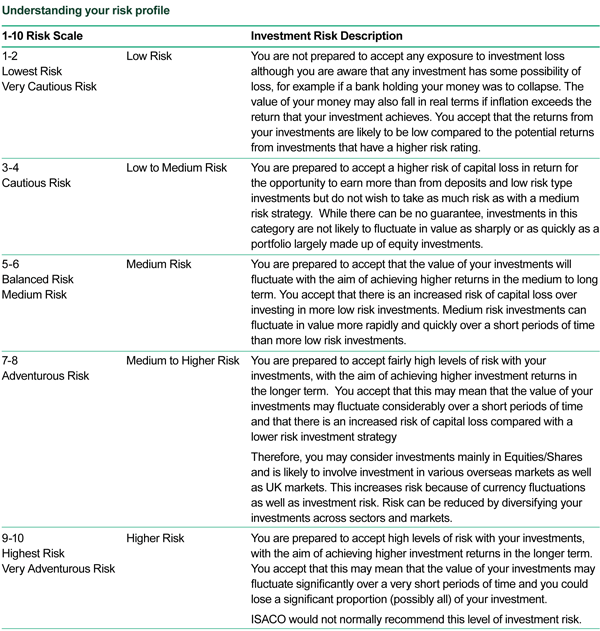 When investing with your ISA and SIPP portfolio, you need to understand the risk involved in the funds you choose to purchase.
When investing with your ISA and SIPP portfolio, you need to understand the risk involved in the funds you choose to purchase.
We all have different attitudes to investment risk. Some people are willing to accept greater risk and volatility in the pursuit of higher returns. Other people are looking for less risk, while still aiming to achieve their personal financial goals.
The table below will help you understand your risk profile. Which description most closely matches your attitude to investment risk?

Aiming for higher returns results in higher volatility
The level of risk and volatility you face is directly linked to where your ISA and SIPP portfolio is invested. The rule is simple: the higher the returns, the higher the volatility. To put it another way, the greater returns you are aiming for, the rockier the ride. Here’s a table that explains how volatility works.

3 year* returns: Adventurous investor seeking aggressive growth
Our personal investment service allows you to buy the same funds as a star-performing investor. You find out where he invests, keep full control of your account, enjoy a close relationship with a trusted expert, and benefit from the potential for attractive long-term returns. The expert that you have the opportunity to mirror is classed as an ‘adventurous’ investor and aims for high returns. That means the ride quality can be uncomfortable at times especially for low to medium risk investors. Take a look at these recent 3 year* returns from the investor.

Attaining this impressive performance over the last the last three years involved periods of increased volatility. If the threat of large price swings over the short-term doesn’t appeal to you, and you’d be willing to aim for a lower annual return in exchange for a smoother ride, you may like my next suggestion.
A simple way to lower volatility – Moneybuilder Income Fund
Instead of investing 100% of your ISA and SIPP into higher risk growth funds, you make a split. For example, 50% of your capital is invested into growth funds and the other 50% is invested into a quality low risk corporate bond fund, resulting in a smoother ride but at the expense of lower returns. If you had adopted such a strategy over the last three years, the results would have been as follows.
3 year* returns: Medium risk investor seeking moderate growth

For more information about investment risk, please visit our other posts on this subject. ISACO are ‘not allowed to give personal recommendations’ which means we are limited to advice that does not consist of tailored recommendations to individuals and does not amount to a ‘personal recommendation’ as defined in the FSA handbook. Should you have any doubts as to the suitability of an investment for your circumstances, we suggest you speak to a financial adviser.
As always, if you have any questions or thoughts on the points I've covered, please leave a comment below or connect with us @ISACO_ on Twitter.
Please note past performance should not be used as a guide to future performance, which is not guaranteed. Investing in Funds should be considered a long-term investment. The value of the investment can go down as well as up and there is no guarantee that you will get back the amount you originally invested.
Find out where an expert invests
Are you an ISA or SIPP investor with over £100,000 actively invested? Are you looking for better returns but are unsure which funds to invest in? ISACO Wealth, our personal investment service, allows you to buy the same funds as a star-performing investor. You find out where he invests, keep full control of your account, enjoy a close relationship with a trusted expert, and benefit from the potential for attractive long-term returns.
To find out where an expert invests >>













